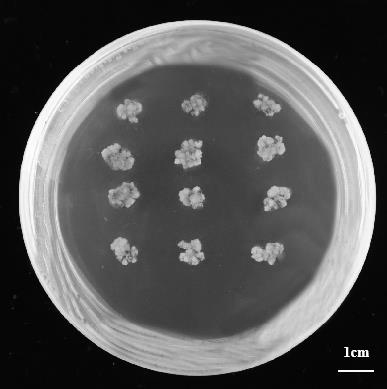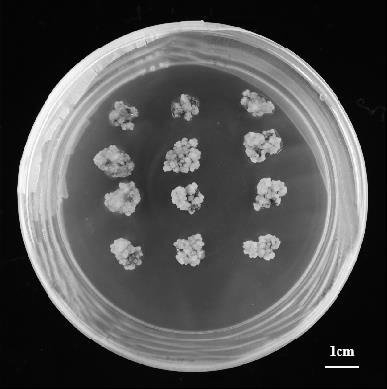A method for callus induction and proliferation of water lily mature embryos
A callus induction and callus technology, applied in the field of plant tissue culture, can solve the problems of unresolved callus proliferation and inapplicable seed disinfection, etc., and achieve the effect of fast callus proliferation
- Summary
- Abstract
- Description
- Claims
- Application Information
AI Technical Summary
Problems solved by technology
Method used
Image
Examples
Embodiment 1
[0053] A method for inducing and proliferating mature embryo callus of water lily, comprising the following steps:
[0054] (1) Pretreatment of mature embryos: Take plump and healthy mature embryos of snow-white water lilies for testing, rinse them under running water for 2 hours, then place them in 10g / L carbendazim solution at room temperature for vortex disinfection for 20 minutes, and rinse them with distilled water for 3~5 hours. Repeat until no carbendazim solution remains.
[0055] (2) Preparation of induction medium: prepare callus induction medium, the medium composition is 1 / 2MS + 1.5mg / L 2,4-D + 0.5 mg / L TDZ + 50g / L sucrose + 8g / L agar , the preparation method is to weigh 2.47g of 1 / 2MS medium (commercially available 1 / 2MS solid medium, without agar and sucrose), 8g of agar and 50g of sucrose in an enamel tank, add 1L of distilled water to heat and dissolve, and then add auxin 2,4-D 1.5mg, cytokinin TDZ 0.5mg, adjust pH to 5.8 with 1 mol / L NaOH, sterilize at 121°C ...
Embodiment 2
[0066] Others are the same as in Example 1, except that the addition amount of TDZ in the induction medium is 0.2 mg / L, and the addition amount of 2,4-D is 1.5 mg / L.
Embodiment 3
[0068] Others are the same as in Example 1, except that the addition amount of TDZ in the induction medium is 0.2 mg / L, and the addition amount of 2,4-D is 2.0 mg / L.
PUM
 Login to View More
Login to View More Abstract
Description
Claims
Application Information
 Login to View More
Login to View More - R&D
- Intellectual Property
- Life Sciences
- Materials
- Tech Scout
- Unparalleled Data Quality
- Higher Quality Content
- 60% Fewer Hallucinations
Browse by: Latest US Patents, China's latest patents, Technical Efficacy Thesaurus, Application Domain, Technology Topic, Popular Technical Reports.
© 2025 PatSnap. All rights reserved.Legal|Privacy policy|Modern Slavery Act Transparency Statement|Sitemap|About US| Contact US: help@patsnap.com



